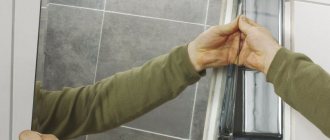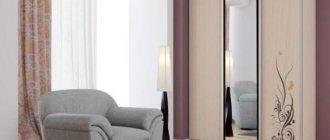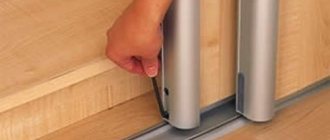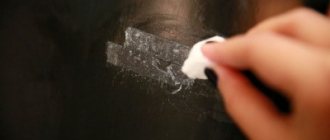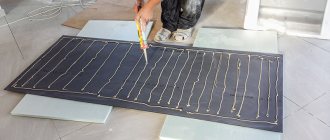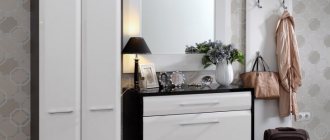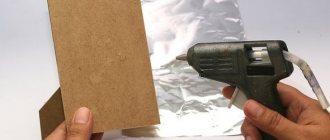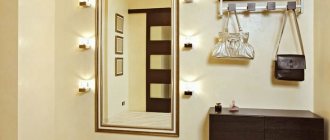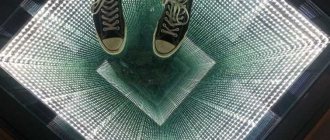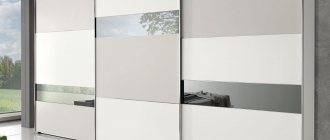A mirror on the closet door greatly simplifies the process of selecting the optimal clothes; all the results of fittings can be seen immediately and the final decision can be made. Some types of modern furniture cabinets have a large mirror on the front door, but not all.
In addition, most old designs did not provide this element. It is not advisable to buy a new cabinet just because of the mirror; it is much more profitable to reconstruct it and glue it to the front door. Let's look at ways to solve the problem and give practical advice.
How to glue a mirror to a cabinet door
Required materials and tools
The key to successful work is the use of exclusively high-quality materials. First of all, you need to purchase special silicone for mirrors and glass at a hardware store.
Silicone for mirrors
If a store offers you liquid nails marked “for mirrors,” you can safely use them.
Next we will need a composition for degreasing the surface. You can use white alcohol or another universal solvent. And of course, buy a mirror of the right size or order it from a glass workshop.
Be sure to degrease the surface before applying glue.
Tools that will be useful:
- gun for applying silicone;
Silicone gun
tape measure or large ruler;
Roulette
- screwdriver;
Screwdriver - rags for applying degreaser;
Rag and degreaser - weight to press the mirror material against the door.
How to glue a mirror using liquid nails?
Liquid nails are a type of construction adhesive based on synthetic rubber and polymers. There are two types of liquid nails: neoprene and acrylic. The first ones are more durable, water-resistant, but due to the organic solvent content they have an unpleasant odor that lasts for several days.
For work at home, it is recommended to use water-based acrylic liquid nails. They are environmentally friendly, do not smell, and do not harm human health. When using an acrylic composition, there is no need to ventilate the room for a long time.
Liquid nails are applied using a special device - a gun. If the mirror is small, then glue is applied pointwise, on large objects - in a snake. The surface is first cleaned and degreased.
Fastening process
Let's get started with the work:
- First of all, it is recommended to prepare the workplace. It is better to place the door on some kind of flooring, so as not to worry about the surface of the floor or table on which the work will be performed.
- On the door you need to draw the correct placement of the mirror using a template. If you glue it unevenly, it will ruin the appearance of the cabinet.
The markings must be as accurate as possible, otherwise the canvas will stick unevenly.
- Let's move on to degreasing the surface: to do this, wet a rag with a special solvent and apply it to both surfaces that will be bonded in the future. Moreover, when working with a mirror, you need to be extremely careful so as not to damage it. To do this, it is recommended to spread some kind of blanket and only place our workpiece on it. And then start treating the back of the glass with a degreasing agent.
- Insert a tube of silicone into the gun, cut off its edge and you can start applying the product to the surface. It is better to do this in a zigzag pattern in increments of no more than 10 cm.
The margins from the edges are about 3 cm.
- As soon as silicone has been applied to the back side, the workpiece must be placed on the door according to the drawn marks. To do this, it is recommended to place the edge of the glass in the drawn corner and align the sheet along the side line. If the mirror blank is large, it is better to use the help of a friend.
- The glass is gently pressed against the surface of the door. Care must be taken to ensure that it does not move or warp. All lines along the mark must coincide with the edges of the workpiece.
- The final fixation on the door will occur in a day. During this time, you need to place heavy objects on the surface that will improve the adhesion of the materials. The main thing is that it is a uniform load.
After gluing the mirror, wait a few minutes to check that it is securely attached.
If you see a slight shift or deviation from the markings, you can immediately correct everything. With a slight movement, while the silicone has not yet hardened, you can move the sheet. After a while this can no longer be done.
What kind of glue can I use?
The second method of attaching a mirror to a door involves using glue. Not every adhesive composition is suitable for such work. You should take exactly the glue whose instructions indicate that it can be used to glue glass or a mirror to vertically located surfaces.
Glue brands that are suitable for gluing mirrors to chipboard:
- "Tytan" A product from a Polish manufacturer based on organic resins and rubber. Characterized by high adhesion and water resistance. The main advantage is that it preserves the amalgam. For proper application, both surfaces are degreased, then one of them is coated with glue (the distance between the strips should be 5 cm, the distance from the edges should be 2 cm). The product dries in a few minutes, but if the mirror hangs crookedly, it can be moved within 1–2 minutes without compromising the adhesion strength.
- "Abro." Two-component adhesive glues not only glass to wood and chipboard, but also glass fragments to each other. The package contains two ampoules, one contains an epoxy resin adhesive base, and the other contains an activator. Before use, these substances must be mixed together in a separate container and then applied to the surface. Ultra-strong fixation allows the product to be used even for gluing rear-view mirrors in cars. Dries in 1–2 minutes.
- "Loctite" Like the previous brand, it includes two components: an adhesive base and an activator. The packaging is enough for either one full-length mirror or two small ones. There is also a one-component cyanoacrylate adhesive for difficult-to-glue surfaces and an aerosol formulation.
- "Permatex". One-component automotive adhesive, which is also used for gluing glass to furniture. Made from cyanoacrylate, it gives a very strong grip. Waterproof, which means it is suitable for mounting mirrors in the bathroom.
- "DoneDeal". Many craftsmen recommend using silicone compounds for working with mirrors, and this adhesive-sealant is just one of them. One of the areas of application is fastening decorative mirror panels. Suitable for gluing small mirrors; it will not hold massive ones.
Types of mounting a mirror to a door
There are several types of fastening to the cabinet door:
- Attach with double-sided tape. This method is one of the easiest and fastest. Because the mirror sheet will be fixed in literally five minutes. And if necessary, you can simply tear the workpiece from the cabinet and attach it to another place;
Correct distribution of adhesive tape when gluing a mirror
It is recommended to use double-sided tape only for small mirror sheets. Because this composition will not withstand heavy loads, and under its own weight it may fall off and break.
- using liquid nails marked “for mirrors” is a reliable option, but after fixing, the mirror surface cannot be separated from the cabinet;
Liquid nails for mirrors - for specialized compounds for mirror and glass surfaces, for example, silicone. In this case, it is extremely important to perform all operations accurately, otherwise the work will not be successful. It will not be possible to remove the glass from the door and any mistake will be fatal;
Distribution of silicone for subsequent gluing of the mirror to the door - through the mechanical method, when various fasteners are used, for example, metal staples, through holders or furniture fasteners with decorative overlays.
Mirror on metal brackets
You can stick a compartment to the door of a closet without having any experience in this matter, and with the help of improvised means. A minimum amount of materials that can be purchased at any hardware store and a standard tool are all you need to install and secure. And most importantly, our instructions with a step-by-step description of each stage of work.
Special double-sided tape: where to buy, how to use?
The easiest way to attach it is with double-sided mounting tape. You should not buy the one sold in office supply stores. Household adhesive tape is designed for gluing paper or cardboard, it will not withstand heavy objects. Having glued the mirror with stationery tape, after just a few minutes you will have to remove the fragments from the floor - the tape will quickly peel off under its weight.
For reliable fastening you need a special mounting tape - double-sided and foam. It is designed to hold sheet materials, including glass, and is sold in construction and automotive stores, with the second option being preferable. Automotive adhesive tapes are highly durable because they are used to fasten parts that are subject to high loads.
How to remove and insert into kitchen cabinet door?
Most often in kitchen cabinets it is secured using plastic L-shaped fasteners and self-tapping screws. It is easy to replace such glass sheet.
- Remove the cabinet door, place it on a horizontal surface, covering it with a soft cloth to avoid scratching the facade.
- Use a screwdriver to unscrew the screws, remove the holders, carefully remove the fragment and put it aside.
- Place a new canvas on the façade, ensuring that the edges overlap the façade equally. This is necessary to avoid accidentally fixing the glass, leaving the glass holder visible from the outside.
- The first element is fixed at a distance of 5 cm from the edge, the subsequent ones - 20 cm from each other.
If you are afraid that the glass holders may not support the weight, place them larger at a shorter distance.When using new glass holders, pierce them with an awl to make tightening the screws easier.
- Using a screwdriver, gradually screw in the screws so that the workpiece does not burst from excessive force.
Attention
Glass holders will firmly secure the new fragment to the facade of the kitchen cabinet. There is no risk that it will come off or fall off.
Mounting to plastic holders is the simplest, but least aesthetically pleasing way.
